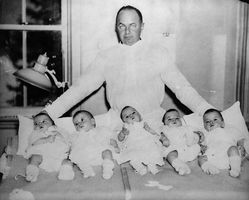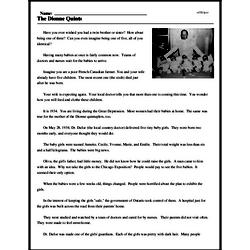The Dionne Quints
Have you ever wished you had a twin brother or sister? How about being one of three? Can you even imagine being one of five, all of you identical?
Having many babies at once is fairly common now. Teams of doctors and nurses wait for the babies to arrive.
Imagine you are a poor French-Canadian farmer. You and your wife already have five children. The most recent one (the sixth) died just after he was born.
Your wife is expecting again. Your local doctor tells you that more than one is coming this time. You wonder how you will feed and clothe these children.
It is 1934. You are living during the Great Depression. Most women had their babies at home. The same was true for the mother of the Dionne quintuplets, too.
On May 28, 1934, Dr. Dafoe (the local country doctor) delivered five tiny baby girls. They were born two months early, and everyone thought they would die.
The baby girls were named Annette, Cecile, Yvonne, Marie, and Emilie. Their total weight was less than six and a half kilograms. The babies were big news.
Oliva, the girl's father, had little money. He did not know how he could raise the girls. A man came to him with an idea. Why not take the girls to the Chicago Exposition? People would pay to see the five babies. It seemed their only option.
When the babies were a few weeks old, things changed. People were horrified about the plan to exhibit the girls.




